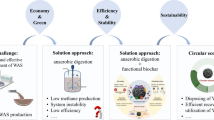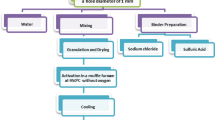Abstract
Textile wastewater pollution is one of the primary global environmental concerns. The textile wastewater contains complex inorganic dyes, which are difficult to treat with conventional treatment processes. A single treatment method is usually insufficient to treat the wastewater up to the level that it meets the stringent textile effluent standards. Hence, a hybrid approach by combining the thermolysis catalyzed by CuSO4 5H2O with heterogeneous Fenton process catalyzed by modified coal fly ash was evaluated in this study for the treatment of textile wastewater. A combination of catalytic thermolysis and coagulation with poly aluminum chloride (PAC) was also studied for comparative purposes. Optimization of treatment processes was done by Response Surface Methodology (RSM) using Minitab software. Catalytic thermolysis was optimized at a pH of 7.05, CuSO4 5H2O dose of 1629 mg/L, and a temperature of 65.3 ℃. Coagulation was optimized at pH of 8.1 and PAC dose of 286.3 mg/L, and the heterogeneous Fenton process was optimized at pH 7.75, a ratio of H2O2/Fe+2 of 3.02, Fe+2 dose of 15 mg/L, and reaction time of 53.5 min. At optimized conditions, two hybrid treatments were run. It was found that the novel combination of catalytic thermolysis with the heterogeneous Fenton process was more effective for removal of COD (89.5%), Color (98.5%), TSS (95.9%) than the second combination (catalytic thermolysis followed by coagulation using PAC). The BOD5/COD ratio was increased from 0.28 to 0.53 in the novel combination, indicating an effective increase in the biodegradability of wastewater.








Similar content being viewed by others
References
Akhtar S, Ahmad S, Huifang W, Shahbaz A, Ghafoor A, Imran S, Zafar A (2018) An analysis of wastewater irrigation practices and its impacts on the livelihood generation and food chain contamination in Faisalabad District Pakistan. J Environ Sci Health 5(4):33–42
Alibeigi-Beni S, Zare MH, Chenar MP, Sadeghi M, Shirazian S (2021) Design and optimization of a hybrid process based on hollow-fiber membrane/coagulation for wastewater treatment. Environ Sci Pollut Res 28(7):8235–8245
Altin S (2011) Removal of remazol turquoise blue (G-133) and polyvinyl alcohol (PVA) by electrocoagulation using monopolar and bipolar electrodes. Int J Chem React Eng. https://doi.org/10.1515/1542-6580.2580
Badawi AK, Zaher K (2021) Hybrid treatment system for real textile wastewater remediation based on coagulation/flocculation, adsorption and filtration processes: performance and economic evaluation. J Water Process Eng 40:101963
Baird R, Eaton AD, Rice EW, Bridgewater L and Federation WE (2017) Standard methods for the examination of water and wastewater. American Public Health Association. https://books.google.com.pk/books?id=V2LhtAEACAAJ
Bazrafshan E, Alipour MR, Mahvi AH (2016) Textile wastewater treatment by application of combined chemical coagulation, electrocoagulation, and adsorption processes. Desalin Water Treat 57(20):9203–9215
Buthelezi SP, Olaniran AO, Pillay B (2012) Textile dye removal from wastewater effluents using bioflocculants produced by indigenous bacterial isolates. Molecules 17(12):14260–14274
Carmen Z and Daniela S (2012) Textile organic dyes, Charecteristics, polluting effects and separation/elimination procedure. A Critical Overview. 2 https://doi.org/10.5772/32373
Costa R, Lelis M, Oliveira L et al (2006) Novel active heterogeneous Fenton system based on Fe3−xMxO4 (Fe Co, Mn, Ni): the role of M2+species on the reactivity towards H2O2 reactions. J Hazard Mater 129:171–178
Freitas T, Oliveira V, De Souza M, Geraldino H, Almeida V, Fávaro S, Garcia J (2015) Optimization of coagulation-flocculation process for treatment of industrial textile wastewater using okra (A. esculentus) mucilage as natural coagulant. Ind Crops Prod 76:538–544
GilPavas E, Dobrosz-Gómez I, Gómez-García MÁ (2018) Optimization of sequential chemical coagulation-electro-oxidation process for the treatment of an industrial textile wastewater. J Water Process Eng 22:73–79
Gita S, Hussan A, Choudhury T (2017) Impact of textile dyes waste on aquatic environments and its treatment. Environ Ecol 35(3C):2349–2353
Gosavi VD, Sharma S (2014) A general review on various treatment methods for textile wastewater. J Env Sci Comput Sci Eng Technol 3(1):29–39
Hai FI, Yamamoto K, Fukushi K (2007) Hybrid treatment systems for dye wastewater. Crit Rev Environ Sci Technol 37(4):315–377
Hossain L, Sarker SK, Khan MS (2018) Evaluation of present and future wastewater impacts of textile dyeing industries in Bangladesh. Environ Dev 26:23–33
Kang S-F, Liao C-H, Po S-T (2000) Decolorization of textile wastewater by photo-Fenton oxidation technology. Chemosphere 41(8):1287–1294
Karthikeyan S, Titus A, Gnanamani A, Mandal A, Sekaran G (2011) Treatment of textile wastewater by homogeneous and heterogeneous Fenton oxidation processes. Desalination 281:438–445
Khan S and Malik A (2014) Environmental and health effects of textile industry wastewater. Int J Environ Res Public Health 55–71
Kumar P, Prasad B, Mishra I, Chand S (2008a) Decolorization and COD reduction of dyeing wastewater from a cotton textile mill using thermolysis and coagulation. J Hazard Mater 153(1–2):635–645
Maleki Rizi MH, Aghabarari B, Alizadeh M et al (2019) The role of cobalt and copper nanoparticles on performance of magnetite-rich waste material in Fenton reaction. Int J Environ Sci Technol 16:373–382. https://doi.org/10.1007/s13762-017-1579-5
Man LW, Kumar P, Teng TT, Wasewar KL (2012) Design of experiments for Malachite green dye removal from wastewater using thermolysis–coagulation–flocculation. Desal Water Treat 40(1–3):260–271
Manenti DR, Módenes AN, Soares PA, Espinoza-Quiñones FR, Boaventura RA, Bergamasco R, Vilar VJ (2014) Assessment of a multistage system based on electrocoagulation, solar photo-Fenton and biological oxidation processes for real textile wastewater treatment. J Chem Eng 252:120–130
Merck (2014) Spectroquant pharo-300 Operating Manual. In. Germany: Merck KGaA
Metcalf L, Eddy HP, Tchobanoglous G (2003) Wastewater engineering: treatment and reuse. Fourth edition / revised by George Tchobanoglous, Franklin L. Burton, H. David Stensel. Boston : McGraw-Hill, [2003] ©2003 https://search.library.wisc.edu/catalog/999935704402121
Murtaza G and Zia MH (2012) Wastewater production, treatment and use in Pakistan. Second regional workshop of the project ‘safe use of wastewater in agriculture'
Natasha SM, Khalid S, Murtaza B, Anwar H, Shah AH, Sardar A, Shabbir Z, Niazi NK (2020) A critical analysis of wastewater use in agriculture and associated health risks in Pakistan. Environ Geochem Health 45:1–20. https://doi.org/10.1007/s10653-020-00702-3
NEQS (2000) EPD National Environmental Quality Standards. EPD. Retrieved 8, October from https://www.elaw.org/system/files/RevisedNEQS.pdf
Nidheesh PV (2015) Heterogeneous Fenton catalysts for the abatement of organic pollutants from aqueous solution: a review. RSC Adv 5(51):40552–40577. https://doi.org/10.1039/C5RA02023A
Nigam M, Rajoriya S, Singh SR, Kumar P (2020) Thermal catalytic treatment (thermolysis): an effective process for the removal of COD and color from industrial wastewater. J Environ Treat Tech 8(2):818–826
Ntampou X, Zouboulis A, Samaras P (2006) Appropriate combination of physico-chemical methods (coagulation/flocculation and ozonation) for the efficient treatment of landfill leachates. Chemosphere 62(5):722–730
Oliveira JA, Oliveira OJ, Ometto AR, Ferraudo AS, Salgado MH (2016) Environmental management system ISO 14001 factors for promoting the adoption of cleaner production practices. J Clean Prod 133:1384–1394
Olmez-Hanci T, Pala-Ozkok I, Orhon D, Sözen S (2021) Advanced oxidation of segregated streams for effective color removal from denim processing effluents. Biointerf Res Appl Chem 12(1):391–404
Du Plessis PW, Ojumu TV, Petrik LF (2013) Waste minimization protocols for the process of synthesizing zeolites from South African coal fly ash. Materials 6(5):1688–1703
Punzi M, Nilsson F, Anbalagan A, Svensson BM, Jönsson K, Mattiasson B, Jonstrup M (2015) Combined anaerobic–ozonation process for treatment of textile wastewater: removal of acute toxicity and mutagenicity. J Hazard Mater 292:52–60
Rice EW, Bridgewater L (2017) American Public Health Association (eds) Standard methods for the examination of water and wastewater. American public health association, Washington
Rodriguez-Narvaez OMP-H, Manuel J, Goonetilleke A, Bandala ER (2017) Treatment technologies for emerging contaminants in water: A review. Chem Eng J 323:361–380
Sánchez-Carnerero EM, Agarrabeitia AR, Moreno F, Maroto BL, Muller G, Ortiz MJ, de la Moya S (2015) Circularly polarized luminescence from simple organic molecules. Chem Euro J 21(39):13488–13500
Dos Santos AB, Cervantes FJ, Van Lier JB (2007) Review paper on current technologies for decolourisation of textile wastewaters: perspectives for anaerobic biotechnology. Biores Technol 98(12):2369–2385
da Silva LS, Gonçalves MMM, Raddi de Araujo LR (2019) Combined photocatalytic and biological process for textile wastewater treatments. Water Environ Res 91(11):1490–1497
Solís-López M, Durán-Moreno A, Rigas F, Morales A, Navarrete M, Ramírez-Zamora R (2014) Assessment of copper slag as a sustainable Fenton-type Photocatalyst for water disinfection. In Water reclamation and sustainability pp 199–227 Elsevier
Solmaz SKA, Birgül A, Üstün GE, Yonar T (2006) Colour and COD removal from textile effluent by coagulation and advanced oxidation processes. Color Technol 122(2):102–109
Sow J, Hot C, Tribout C, Cyr M (2015) Characterization of Spreader Stoker Coal Fly Ashes (SSCFA) for their use in cement-based applications, Fuel 162:224–233. https://doi.org/10.1016/j.fuel.2015.09.017
Stoch A (2015) Fly ash from coal combustion-characterization. Praca doktorska
Teng TT and Low LW (2012) Removal of dyes and pigments from industrial effluents. In Advances in Water Treatment and Pollution Prevention pp 65–93 Springer
Verma AK, Dash RR, Bhunia P (2012) A review on chemical coagulation/flocculation technologies for removal of colour from textile wastewaters. J Environ Manag 93(1):154–168
Wang N, Chen J, Zhao Q, Xu H (2017) Study on preparation conditions of coal fly ash catalyst and catalytic mechanism in a heterogeneous Fenton-like process. RSC Adv 7(83):52524–52532
Wulandari WR, Saefumillah A and Yunarti RT (2020) Modification of fly ash using acids and alkali by hydrothermal method and its application as adsorbents material for phosphate adsorption in aquatic system. In IOP Conference Series: Materials Science and Engineering 902(1) p 012034 IOP Publishing
ZDHC (2019) ZDHC Wastewater Guidelines Version 1.1. Stichting ZDHC Foundation. https://uploads-ssl.webflow.com/5c4065f2d6b53e08a1b03de7/5db70334bd2f007e2fbc8577_ZDHC_WastewaterGuidelines_V1.1_JUL19_compressed%20(1).pdf
Acknowledgements
The authors would like to thank the Institute of Environmental Engineering and Research (IEER) at the University of Engineering and Technology, Pakistan, for providing resources and lab facilities to conduct experimentation.
Author information
Authors and Affiliations
Corresponding author
Ethics declarations
Conflict of interest
The authors have no relevant financial or non-financial interests to disclose.
Ethical approval
No human or animal specimens have been used in this study.
Consent to participate
All authors agreed with the content and provided clear support to submit.
Consent for publication
All authors agreed with the publication of the article in the International Journal of Environmental Science and Technology.
Additional information
Editorial responsibility: Maryam Shabani.
Rights and permissions
Springer Nature or its licensor (e.g. a society or other partner) holds exclusive rights to this article under a publishing agreement with the author(s) or other rightsholder(s); author self-archiving of the accepted manuscript version of this article is solely governed by the terms of such publishing agreement and applicable law.
About this article
Cite this article
Ashar, U.U., Anis, M., Hussain, G. et al. Hybrid treatment of textile wastewater through catalytic thermolysis and catalytic heterogeneous Fenton processes. Int. J. Environ. Sci. Technol. (2024). https://doi.org/10.1007/s13762-024-05695-5
Received:
Revised:
Accepted:
Published:
DOI: https://doi.org/10.1007/s13762-024-05695-5




